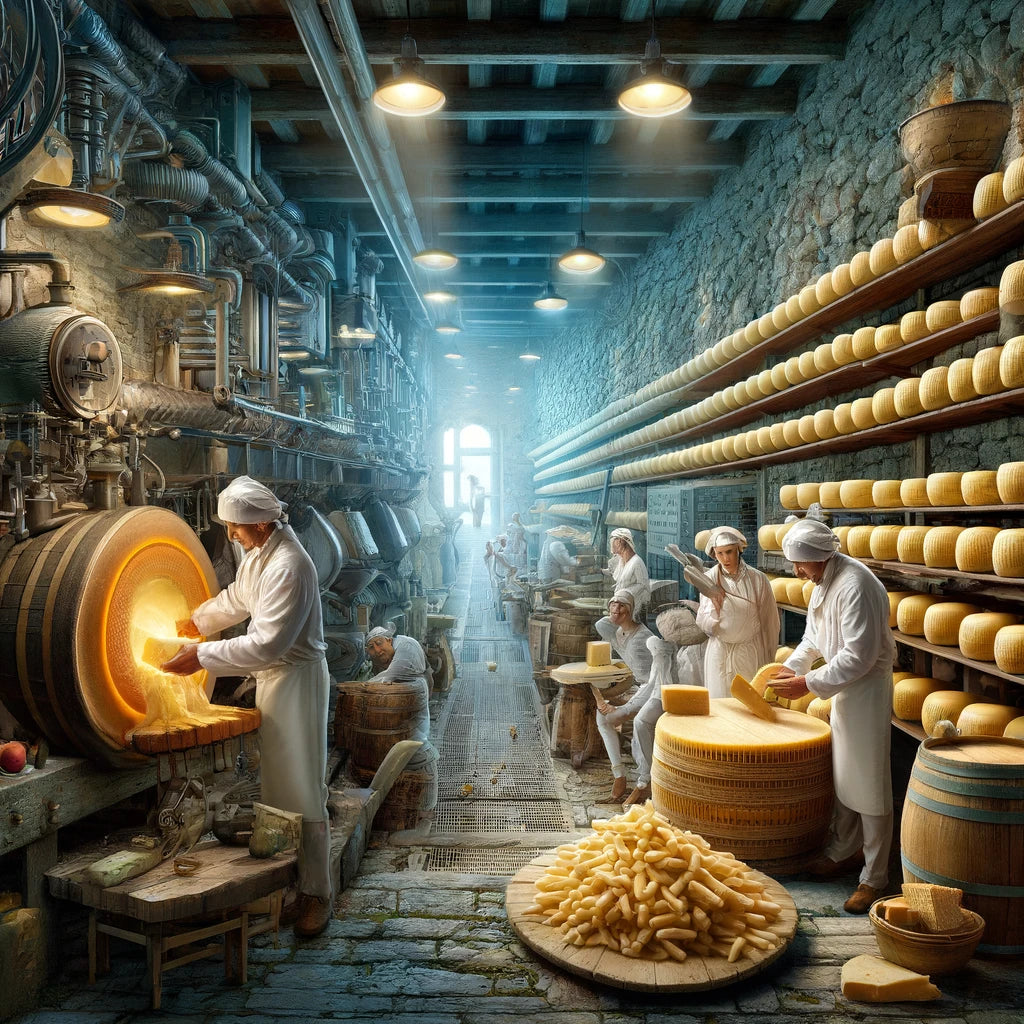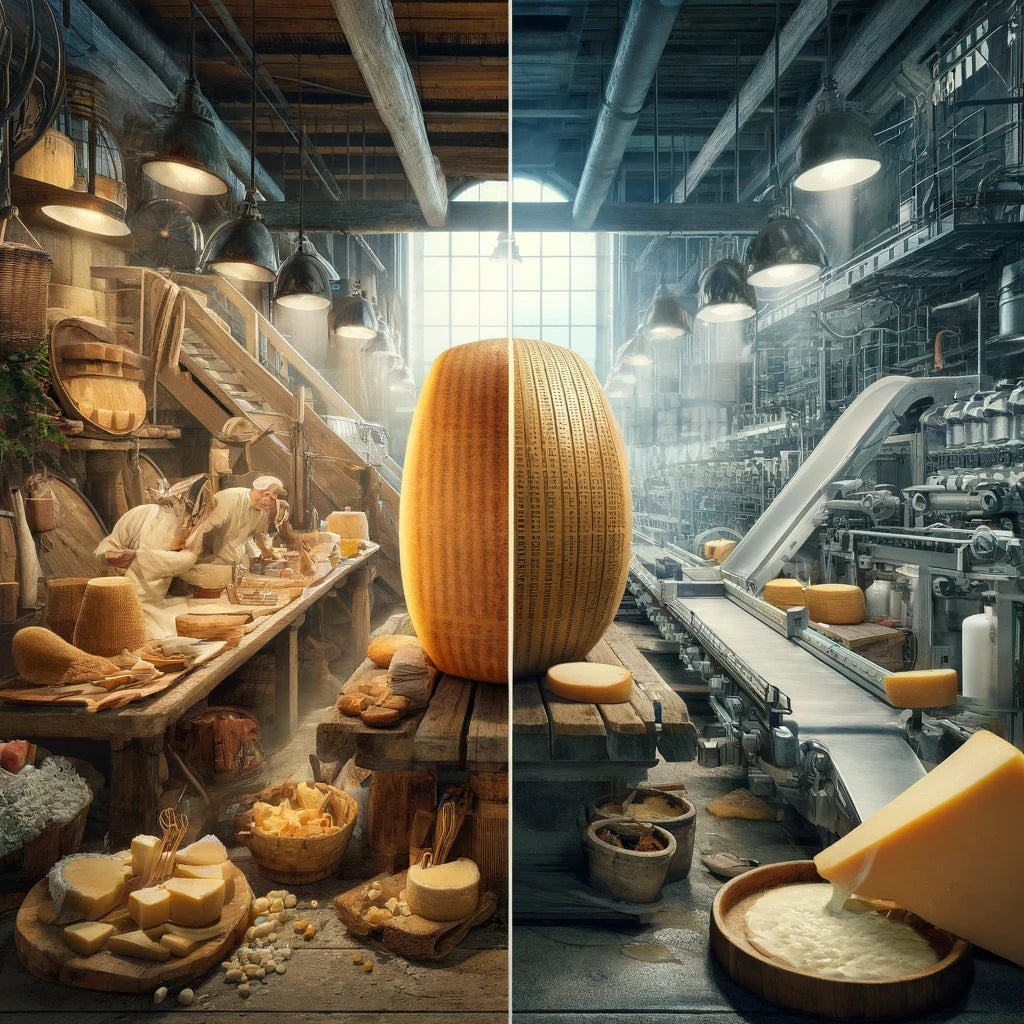Traditional Artisanal Methods vs. Industrial Production of Parmesan Cheese
The world of cheese is as vast as it is flavorful, with methods of production that have evolved over centuries. Parmesan cheese, a staple in many cuisines worldwide, stands out not only for its rich flavor but also for the dichotomy in its production methods: the traditional artisanal methods versus industrial production. This debate is not just about taste; it encompasses the essence of cheese-making, the impact on quality, and the choice between Unprocessed Cheese and mass-produced alternatives.
The Essence of Artisanal Cheese Production
History and Tradition of Artisanal Cheese
The art of cheese-making dates back millennia, with artisanal cheese production deeply rooted in tradition and local cultures. These methods, passed down through generations, emphasize a hands-on approach, minimal processing, and the use of high-quality, often local, ingredients. Parmesan cheese, made traditionally, is a testament to these practices, embodying the flavors and the essence of its region of origin.
Artisanal Methods Explained
Traditional artisanal methods of making Parmesan cheese involve raw, unpasteurized milk, natural rennet, and a meticulous aging process, often in cellars or caves where the environment contributes to the cheese's unique flavor profile. This process, inherently slow and labor-intensive, allows for the development of a complex flavor and texture that industrial methods struggle to replicate.

The Role of Local Environment and Ingredients
The concept of terroir is pivotal in artisanal cheese production. The local environment, including the flora and fauna, plays a crucial role in defining the unique characteristics of the cheese. For Parmesan cheese, this means sourcing milk from specific breeds of cows grazing on local pastures. The result is a cheese that not only tastes distinct but also carries the essence of its place of origin.
Industrial Cheese Production: A Modern Approach
The Rise of Industrial Cheese-Making
The industrial revolution introduced new technologies and methods to cheese production, focusing on efficiency, consistency, and scalability. This shift allowed for the mass production of cheese, including Parmesan cheese, making it more accessible to a wider audience. However, this efficiency often comes at the cost of sacrificing traditional flavors and the artisanal touch.
Techniques and Technologies in Industrial Production
Industrial production of Parmesan cheese involves pasteurized milk, mechanized stirring and pressing, and controlled aging environments. These methods ensure uniformity and speed up the production process, catering to the demands of a global market. Yet, this can often lead to a product that lacks the depth of flavor and texture characteristic of its artisanal counterpart.
Quality vs. Quantity: The Industrial Trade-off
The primary advantage of industrial production is its ability to produce large quantities of cheese at a lower cost. However, this often leads to compromises in quality, with many industrial cheeses, including variants of vegan cheese and low fat cheese, relying on additives and processed ingredients to achieve desired textures and flavors.
Consumer Perspective
Price and Accessibility
Industrial cheese production has made cheeses, including Parmesan cheese and mozzarella cheese, more accessible to consumers worldwide, often at a lower price point than artisanal cheeses. This accessibility has played a crucial role in introducing various cheese varieties to new markets and consumers.
Making an Informed Choice
For consumers, the choice between artisanal and industrial cheeses often boils down to personal preference, values, and budget. Those valuing tradition, flavor, and artisanal craftsmanship might lean towards artisanal Parmesan cheese, while others might prioritize the convenience and consistency of industrial cheeses. Labels such as best mozzarella cheese in India or plant-based cheese can guide consumers towards products that meet their dietary preferences and ethical considerations.
Evolving Consumer Trends in Cheese Consumption
In recent years, consumer preferences have shifted towards more ethical, sustainable, and health-conscious choices in food consumption. This shift has had a significant impact on the cheese industry, with an increasing demand for vegan cheese and plant based cheese options. These products cater to both ethical concerns around animal welfare and dietary restrictions or preferences. Moreover, there's a growing appreciation for unprocessed cheese, which aligns with the broader trend towards natural and minimally processed foods.
- Vegan Cheese: A growing segment of the market seeks dairy-free options, driving innovation in vegan cheese made from nuts, soy, and other plant sources.
- Plant-Based Cheese: Similar to vegan options, plant-based cheese caters to those looking for dairy alternatives due to health reasons, ethical considerations, or environmental concerns.
- Unprocessed Cheese: Amidst rising awareness about the health implications of processed foods, consumers are gravitating towards Unprocessed Cheese for its perceived health benefits and authenticity.

The Future of Cheese Production: Sustainability and Innovation
As consumer preferences evolve, so too does the cheese industry. The future of cheese production is likely to be characterized by a focus on sustainability, technological innovation, and adapting to changing dietary trends.
- Sustainability: Both artisanal and industrial producers are increasingly adopting practices to minimize environmental impact, such as reducing water usage, employing renewable energy, and sourcing ingredients locally.
- Technological Innovation: Advances in technology are enabling both traditional and industrial producers to improve efficiency, traceability, and quality. For example, digital tools and AI are being used to monitor aging processes and predict flavor development.
- Dietary Trends: The rise of low fat cheese options and the expansion of the Mozzarella Cheese market in regions like India reflect the industry's responsiveness to global dietary trends and health consciousness.
Conclusion
The journey from milk to the mozzarella cheese block on your plate is filled with choices—choices made by producers about methods and materials and by consumers about ethics and health. Whether it's selecting the best mozzarella cheese in india or a slice of Parmesan cheese made using traditional artisanal methods, these choices reflect broader trends and values. As the cheese industry continues to evolve, it remains anchored by its ability to adapt, innovate, and satisfy the diverse tastes and demands of consumers worldwide.








